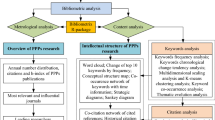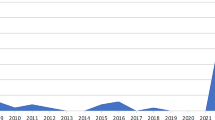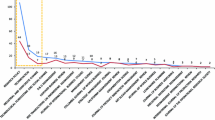Abstract
The last decade has witnessed rapid development in the literature on public–private partnerships (PPPs); however, there have been few attempts to map the global research in this domain. To identify the state of the field and trends in PPP research, the CiteSpace software package was used in this study to conduct a series of content analyses and examine global patterns among publications, including the distribution of core authors and institutions; high-frequency categories and keywords; journal and author contributions; highly cited papers and hot topics of research; and trends with regard to co-author analysis, co-word analysis, co-citation analysis, and particularly cluster analysis. We present all research focuses in a scientometric way and arrive at the following findings. First, the most significant developments and progress in PPP research have occurred primarily in China, the US, the UK and Australia. Second, the existing studies in the field of PPP research focus primarily on Engineering, Business and Economics, and Public Administration. Third, the emerging trends in PPP research have shifted away from concession pricing and concession periods, PPP legislation, procurement management, critical success factors, value for money and PPP project governance toward risk allocation, performance evaluation, renegotiation of concession contracts, real option evaluation and contract management, which are likely to define the new research frontier in the field of PPP research.











Similar content being viewed by others
References
Abednego, M. P., & Ogunlana, S. (2006). Good project governance for proper risk allocation in public–private partnerships in Indonesia. International Journal of Project Management, 24(7), 622–634.
Ahadzi, M., & Bowles, G. (2004). Public–private partnerships and contract negotiations: An empirical study. Construction Management and Economics, 22, 967–978.
Akintoye, A., Hardcastle, C., Beck, M., Chinyio, E., & Asenova, D. (2003). Achieving best value in private finance initiative project procurement. Construction Management and Economics, 21(5), 461–470.
Al-Sharif, F., & Kaka, A. (2004). PFI/PPP topic coverage in construction journals. The 20th annual ARCOM conference (vol. 1, pp. 711–719).
Bennett, J., & Iossa, E. (2006). Building and managing facilities for public services. Journal of Public Economics, 90(10), 2143–2160.
Bloomfield, P. (2006). The challenging business of long-term public–private partnerships: Reflections on local experience. Public Administration Review, 66(3), 400–411.
Boyack, C., Ferrone, S., & Marincola, F. M. (2006). Rewarding patient-directed research: Excellence in translational medicine award. Journal of Translational Medicine, 4, 19.
Brandao, L. E. T., & Saraiva, E. (2008). The option value of government guarantees in infrastructure projects. Construction Management and Economics, 26(11), 1171–1180.
Canadian Council for Public–Private Partnership. (2007). About PPP: Definitions. Retrieved from http://www.pppcouncil.ca/resources/about-ppp/definitions.html.
Chan, A. P. C., Lam, P. T. I., Chan, D. W. M., Cheung, E., & Ke, Y. J. (2010). Potential obstacles to successful implementation of public–private partnerships in Beijing and Hong Kong special administrative region. Journal of Management in Engineering (ASCE), 26(1), 30–40.
Chan, A. P. C., Yeung, J., Yu, C., Wang, S. Q., & Ke, Y. J. (2011). Empirical study of risk assessment and allocation of public–private partnership projects in China. Journal of Construction Engineering Management (ASCE), 27(3), 136–148.
Chen, C. (2000). Domain visualization for digital libraries. IEEE international conference on information visualization (pp. 261–267).
Chen, C. (2006). CiteSpace II: Detecting and visualizing emerging trends and transient patterns in scientific literature. Journal of the American Society for Information Science and Technology, 57(3), 359–377.
Chen, C. (2014). The CiteSpace manual. Retrieved from http://cluster.ischool.drexel.edu/~cchen/citespace.
Cheung, E., & Chan, A. (2011). Risk factors of public–private partnership projects in China: Comparison between the water, power, and transportation sectors. Journal of Urban Planning and Development, 137(4), 409–415.
Chiara, N., Garvin, M., & Vecer, J. (2007). Valuing simple multiple-exercise real options in infrastructure projects. Journal of Infrastructure Systems (ASCE), 13(2), 97–104.
Cobo, M. J., López-Herrera, A. G., Herrera-Viedma, E., & Herrera, F. (2011). Science mapping software tools: Review, analysis, and cooperative study among tools. Journal of the American Society for Information Science and Technology, 62(7), 1382–1402.
Cruz, C. O., & Marques, R. C. (2011). Contribution to the study of PPP arrangements in airport development, management and operation. Transport Policy, 18(2), 392–400.
Cruz, N. F., & Marques, R. C. (2012). Delivering local infrastructure through PPPs: Evidence from the school sector. Journal of Construction and Engineering Management (ASCE), 138(10), 1433–1443.
Delmon, J. (2000). BOO/BOT projects: A commercial and contractual guide. London: Sweet & Maxwell Limited.
Demsetz, H. (1968). Why regulate utilities? The Journal of Law and Economics, 11(1), 55–65.
Dixit, A. K., & Pindyck, R. S. (1994). Investment under uncertainty. Princeton: Princeton University Press.
Environmental Protection Agency. (2009). HUD-DOT-EPA partnership for sustainable communities. Retrieved from http://www2.epa.gov/smart-growth/hud-dot-epa-partnership-sustainable-communities.
Froud, J. (2003). The private finance initiative—risk, uncertainty and the state. Accounting, Organization and Society, 28, 567–589.
Froud, J., & Shaoul, J. (2001). Appraising and evaluating PFI for NHS hospitals. Financial Accountability & Management, 17(3), 247–270.
Girvan, M., & Newman, M. E. J. (2002). Community structure in social and biological netwoks. Proceedings of the National Academy of Science, 99(12), 7821–7826.
Graeme, A., & Greve, C. (2007). Public–private partnerships: An international performance review. Public Administration Review, 67(3), 545–558.
Grimsey, D., & Lewis, M. K. (2002). Evaluating the risks of public private partnerships for infrastructure projects. International Journal of Project Management, 20(2), 107–118.
Grimsey, D., & Lewis, M. K. (2004). Public private partnerships: The world wide revolution in infrastructure provision and project finance. Cheltenham: Edward Elgar.
Grimsey, D., & Lewis, M. K. (2005). Are public private partnerships value for money? Evaluating alternative approaches and comparing academic and practitioner views. Accounting Forum, 29, 345–378.
Guasch, J. L. (2004). Granting and renegotiating infrastructure concessions: Doing it right. Washington, DC: World Bank Publications.
Guasch, J. L., Laffont, J. J., & Straub, S. (2008). Renegotiation of concession contracts in Latin America: Evidence from the water and transport sectors. International Journal of Industrial Organization, 26(2), 421–442.
Gurgun, A. P., & Touran, A. (2014). Public–private partnership experience in the international arena: Case of Turkey. Journal of Management in Engineering (ASCE), 30(6), 04014029.
Hart, O. (2003). Incomplete contracts and public ownership: Remarks, and an application to public–private partnerships. The Economic Journal, 113(486), 69–76.
Heald, D. (2003). Value for money tests and accounting treatment in PFI schemes. Accounting, Auditing & Accountability Journal, 16(3), 342–371.
Hjørland, B., & Albrechtsen, H. (1995). Toward a new horizon in information science: Domain-analysis. Journal of the American Society for Information Science, 46(6), 400–425.
Hodge, G. A., & Greve, C. (2007). Public–private partnerships: An international performance review. Public Administration Review, 67(3), 545–558.
Hodge, G., & Greve, C. (2010). Public–private partnerships: Governance scheme or language game? Australian Journal of Public Administration, 69(1), 8–22.
Huang, Y. L., & Chou, S. P. (2006). Valuation of the minimum revenue guarantee and the option to abandon in BOT infrastructure projects. Construction Management and Economics, 24(4), 379–389.
Jin, X. H. (2010a). Neurofuzzy decision support system for efficient risk allocation in public–private partnership infrastructure projects. Journal of Computing in Civil Engineering (ASCE), 24(6), 525–538.
Jin, X. H. (2010b). Determinants of efficient risk allocation in privately financed public infrastructure projects in Australia. Journal of Construction Engineering Management (ASCE), 130(2), 138–150.
Jin, X. H., & Doloi, H. (2008). Interpreting risk allocation mechanism in public–private partnership projects: An empirical study in a transaction cost economics perspective. Construction Management and Economics, 26(7), 707–721.
Ke, Y. J., Wang, S. Q., Chan, A. P. C., & Cheung, E. (2009). Research trend of public–private partnership in construction journals. Journal of Construction Engineering Management (ASCE), 135(10), 1076–1086.
Kumaraswamy, M. M., & Zhang, X. Q. (2001). Governmental role in BOT-led infrastructure development. International Journal of Project Management, 19(4), 195–205.
Levy, S. M. (1996). Build, operate, transfer: Paving the way for tomorrow’s infrastructure. New York: Wiley.
Li, B., Akintoye, A., Edwards, P. J., & Hardcastle, C. (2005a). The allocation of risk in PPP/PFI construction projects in the UK. International Journal of Project Management, 23(1), 25–35.
Li, B., Akintoye, A., Edwards, P. J., & Hardcastle, C. (2005b). Critical success factors for PPP/PFI projects in the UK construction industry. Construction Management and Economics, 23(5), 459–471.
Liu, T., Chan, A., & Wang, S. (2014). PPP framework for public rental housing projects in China. International conference on construction and real estate management (ASCE) (pp. 573–581).
Liu, J., Love, P., Carey, B., Smith, J., & Regan, M. (2014b). Ex-ante evaluation of public–private partnerships: Macroeconomic analysis. Journal of Infrastructure Systems (ASCE), 21(2), 04014038.
Marques, R., & Berg, S. (2010). Revisiting the strengths and limitations of regulatory contracts in infrastructure industries. Journal of Infrastructure Systems (ASCE), 16(4), 334–342.
Marques, R. C., & Berg, S. (2011). Risks, contracts, and private-sector participation in infrastructure. Journal of Construction Engineering and Management (ASCE), 137(11), 925–932.
Newman, M. E. J. (2006). Modularity and community structure in networks. PNAS, 103(23), 8577–8582.
Ng, A., & Loosemore, M. (2007). Risk allocation in the private provision of public infrastructure. International Journal of Project Management, 25(1), 66–76.
Osborne, S. (2002). Public–private partnerships: Theory and practice in international perspective. London: Routledge.
Pollock, A. M., Price, D., & Player, S. (2007). An examination of the UK Treasury’s evidence base for cost and time overrun data in UK value-for-money policy and appraisal. Public Money and Management, 27(2), 127–134.
Pouris, A., & Pouris, A. (2011). Scientometrics of a pandemic: HIV/AIDS research in South Africa and the world. Scientometrics, 86(2), 541–552.
Rousseeuw, P. J. (1987). Silhouette: A graphical aid to the interpretation and calidation of cluster analysis. Journal of Computational and Applied Mathematics, 20, 53–65.
Samoylenko, V., Zhao, J., Dunbar, D. C., Khan, I. A., Rushing, J. W., & Muhammad, I. (2006). New constituents from noni (Morinda citrifolia) fruit juice. Journal of Agriculture and Food Chemistry, 54(17), 6398–6402.
Savas, E. S. (2000). Privatization and public–private partnerships. Tavern: Chatham House.
Sharma, D., & Cui, Q. (2012). Design of concession and annual payments for availability payment public private partnership (PPP) projects. In Proceedings of construction research congress, West Lafayette (pp. 22–23).
Shen, L. Y., Li, H., & Li, Q. M. (2002). Alternative concession model for build operate transfer contract projects. Journal of Construction Engineering and Management (ASCE), 128(4), 326–330.
Shen, L. Y., Platten, A., & Deng, X. P. (2006). Role of public private partnerships to manage risks in public sector projects in Hong Kong. International Journal of Project Management, 24(7), 587–594.
Shen, L. Y., & Wu, Y. Z. (2005). Risk concession model for build/operate/transfer contract projects. Journal of Construction Engineering and Management (ASCE), 131(2), 211–220.
Shibata, N., Kajikawa, Y., & Matsushima, K. (2008). Detecting emerging research fronts based on topological measures in citation networks of scientific publications. Technovation, 28(11), 758–775.
Song, J. B., Song, D. R., Zhang, X. Q., & Sun, Y. (2013). Risk identification for PPP waste-to-energy incineration projects in China. Energy Policy, 61, 953–962.
Soomro, M., & Zhang, X. Q. (2015). Evaluation of the functions of public sector partners in transportation public–private partnerships failures. Journal of Management in Engineering (ASCE), 32(1), 04015027.
Spackman, M. (2002). Public–private partnerships: Lessons from the British approach. Economic Systems, 26(3), 283–301.
Tang, L., & Shen, G. (2013). Finance-related critical success factors for the briefing of PPP projects in construction. Proceedings of the International Conference on Construction and Real Estate Management, 2013, 427–437.
Tang, L., Shen, Q., & Cheng, E. W. L. (2009). A review of studies on public–private partnership projects in the construction industry. International Journal of Project Management, 28(7), 683–694.
Tang, L., Shen, Q., Skitmore, M., & Cheng, E. (2013). Ranked critical factors in PPP briefings. Journal of Management in Engineering (ASCE), 29(2), 164–171.
Tiong, R. L. K. (1996). CSFs in competitive tendering and negotiation model for BOT projects. Journal of Construction Engineering and Management (ASCE), 122(3), 205–211.
Tiong, R. L. K., Yeo, K. T., & McCarthy, S. C. (1992). Critical Success Factors in Winning BOT Contracts. Journal of Construction Engineering and Management (ASCE), 118(2), 217–228.
Unit, Efficiency. (2003). Serving the community by using the private sector—An introductory guide to public private partnerships (PPPs). Hong Kong: Hong Kong Special Administrative Region Government.
Vassilakou, A., & Maniatis, A. (2013). PPP in French law and practice. In Proceedings of the 5th annual EuroMed conference of the EuroMed Academy of Business (pp. 1611–1623).
Walker, C., & Smith, A. J. (1995). Privatized infrastructure: The BOT approach. London: Thomas Telford.
Wang, S. Q., Tiong, R. L. K., & Ting, S. K. (2000). Evaluation and management of political risks in China’s BOT projects. Journal of Construction Engineering and Management (ASCE), 126(3), 242–250.
Widdus, R. (2001). Public–private partnerships for health: Their main targets, their diversity, and their future directions. Bulletin of the World Health Organization, 79(8), 713–720.
Williamson, O. E. (1985). The economic institutions of capitalism. New York: The Free Press.
Xu, Y., Chan, A. P. C., & Yeung, J. (2010). Developing a fuzzy risk allocation model for PPP projects in China. Journal of Construction Engineering Management (ASCE), 136(8), 894–903.
Xu, J. W., & Moon, S. (2010). A continuous time NPV model for determining the concession period of BOT project. In Proceedings of the 1st international conference on sustainable construction and risk management (pp. 235–239).
Yang, H., & Meng, Q. (2000). Highway pricing and capacity choice in a road network under a Build–Operate–Transfer scheme. Transportation Research Part A: Policy and Practice, 34(3), 207–222.
Yescombe, E. R. (2011). Public–private partnerships: Principles of policy and finance. Oxford: Butterworth-Heinemann.
Yuan, J. F., Guang, M., Wang, X. X., Li, Q. M., & Skibniewski, M. J. (2012). Quantitative SWOT analysis of public housing delivery by public–private partnerships in China based on the perspective of the public sector. Journal of Management in Engineering (ASCE), 28(4), 407–420.
Zhang, X. Q. (2004). Concessionaire selection: Methods and criteria. Journal of Construction Engineering Management (ASCE), 130(2), 235–244.
Zhang, X. Q. (2005a). Criteria for selecting the private-sector partner in public–private partnerships. Journal of Construction Engineering Management (ASCE), 131(6), 631–644.
Zhang, X. Q. (2005b). Critical success factors for public–private partnerships in infrastructure development. Journal of Construction Engineering Management (ASCE), 131(1), 3–14.
Zhang, X. Q. (2005c). Paving the way for public–private partnerships in infrastructure development. Journal of Construction Engineering Management (ASCE), 131(1), 71–80.
Zhang, X. Q. (2006). Public clients’ best value perspectives of public–private partnerships in infrastructure development. Journal of Construction Engineering Management (ASCE), 132(2), 107–114.
Zhang, X. Q., & Kumaraswamy, M. M. (2001). Procurement protocols for public–private partnered projects. Journal of Construction Engineering and Management (ASCE), 127(5), 351–358.
Acknowledgments
This work was supported by the National Natural Science Foundation of China (Grant Nos. 71272091 and 71472022) and by the Fundamental Research Funds for the Central Universities (DUT14RW210 and DUT15RW148).
Author information
Authors and Affiliations
Corresponding author
Rights and permissions
About this article
Cite this article
Song, J., Zhang, H. & Dong, W. A review of emerging trends in global PPP research: analysis and visualization. Scientometrics 107, 1111–1147 (2016). https://doi.org/10.1007/s11192-016-1918-1
Received:
Published:
Issue Date:
DOI: https://doi.org/10.1007/s11192-016-1918-1




